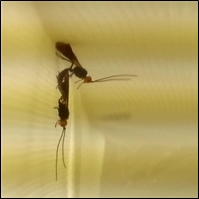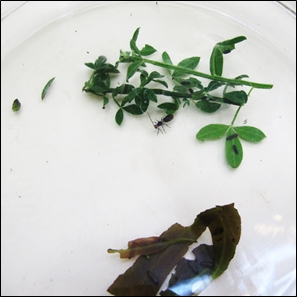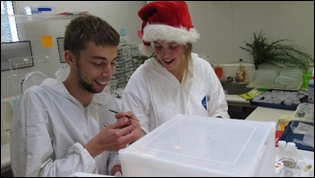PESTS AND DISEASES OF FORESTRY IN NEW ZEALAND
Tasmanian parasitoid keeps entomologists busy in Rotorua containment facility
Scion is the leading provider of forest-related knowledge in New Zealand
Formerly known as the Forest Research Institute, Scion has been a leader in research relating to forest health for over 50 years. The Rotorua-based Crown Research Institute continues to provide science that will protect all forests from damage caused by insect pests, pathogens and weeds. The information presented below arises from these research activities.
From Forest Health News 263, December 2015 - January 2016.

It is time for an update on the progress of the Paropsis biocontrol project, last featured in Forest Health News 253, January 2015. The aim of this three year project is to introduce a biological control agent to target the larval life stage of the eucalyptus tortoise beetle (Paropsis charybdis), New Zealand’s most serious Eucalyptus pest. It is supported by a Sustainable Farming Fund grant to the NZ Farm Forestry Association with co-funding from a number of industry partners, and Scion core funding.

Last summer, entomologists knew that developing a laboratory rearing protocol for the specialist parasitoid Eadya paropsidis from Australia would be a challenge. During 2015 we managed to successfully overwinter a small number of the parasitoids. Daylight hours and temperature were manipulated in a high security containment room to mimic those occurring in Tasmania, where the parasitoid is native. Then it was just a matter o f crossing fingers and waiting. Sure enough, starting from the end of November 2015, and synchronised with the emergence of their Tasmanian cousins, a small number of the parasitoids began to emerge from overwintering. Although a “baby step” in relation to the entire project, this successful overwintering, as well as observing and videoing two successful mating encounters in the laboratory, were both scientific break-throughs for the team.

Over the next two years, non-target beetles closely related to the target pest will need to be screened to ascertain their risk of being attacked in nature. Eadya paropsidis host specificity testing has been initiated this summer, using a combination of no-choice (forced exposure to either target or non-target larvae alone) and two-choice assays (exposed to target and nontarget larvae at the same time). For instance, the tutsan weed leaf beetle Chrysolina abchasica (currently under consideration by Environmental Protection Authority as a potential biological control agent against the weed tutsan1), and the broom leaf beetle, Gonioctena olivacea, have both been subject to screening. They are in the same subfamily as P. charybdis (Chrysomelinae). We have already observed that female E. paropsidis tend to ignore both of these alternative species, instead carefully and repeatedly searching the Eucalyptus leaves, and stalking P. charybdis larvae. While this is promising, the team now need to rear out all the target and non-target larvae and obtain interim results to support those observations.
Toni Withers
1 Gourlay, H. 2015. Tutsan Agents Imminent. Weed Biocontrol What’s New? 74: 5.
This information is intended for general interest only. It is not intended to be a substitute for specific specialist advice on any matter and should not be relied on for that purpose. Scion will not be liable for any direct, indirect, incidental, special, consequential or exemplary damages, loss of profits, or any other intangible losses that result from using the information provided on this site.
(Scion is the trading name of the New Zealand Forest Research Institute Limited.)

 Farm Forestry New Zealand
Farm Forestry New Zealand

